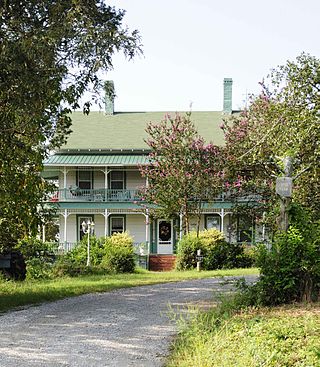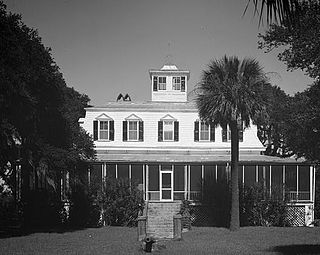
Meggett is a town in Charleston County, South Carolina, United States. The population was 1,226 at the 2010 census. Meggett is part of the Charleston-North Charleston-Summerville metropolitan area.
Westphalia is a small unincorporated community in Falls County, Texas, United States located 35 mi (56 km) south of Waco on State Highway 320. Westphalia has a strong German and Catholic background. The Church of the Visitation was, until recently, the largest wooden church west of the Mississippi River. Westphalia is mainly noted for its historic church and convents, but also for its meat market and for its annual church picnic, which is one of the largest in the area. Westphalia is also known for the Westphalia Waltz.

The William Aiken House and Associated Railroad Structures make up a National Historic Landmark District in Charleston, South Carolina, that contains structures of South Carolina Canal and Railroad Company and the home of the company's founder, William Aiken. These structures make up one of the largest collection of surviving pre-Civil War railroad depot facilities in the United States. The district was declared a National Historic Landmark in 1963.

The Summit Plantation House is an historic building in Adams Run, South Carolina, USA. The house was built for William and Amarinthia Wilkinson in 1819. The house was listed in the National Register on July 28, 1983.

McLeod Farmstead, also known as Rest Park Tract and Seabrook Farms, is a historic farmstead and national historic district located at Seabrook, Beaufort County, South Carolina. The district encompasses 12 contributing building and 2 contributing structures, and is representative of the truck farming economy that spread through the region between 1884 and 1946. The contributing farm buildings include the Keyserling gin and McLeod Barn. Two of the buildings served commercial purposes: The McLeod general store and the Keyserling general store. There are also three residential structures: the McLeod House (1905), a two-room shack which likely housed farm workers, and the residence and the office of the farm supervisor.

Nuckolls-Jefferies House, also known as the Nuckolls House and Wagstop Plantation, is a historic plantation house located near Pacolet, Cherokee County, South Carolina. It was built in 1843, with alterations in the 1870s or 1880s. It is a 2+1⁄2-story, frame residence in a combined Greek Revival / Classical Revival style. It is clad in weatherboard and sits on a stone foundation. The front facade features a two-tiered central, pedimented portico supported by two sets of slender wooden posts. The rear of the house has a two-story ell, built during the 1996 restoration. Also on the property are three contributing outbuildings: a small, one-story log gable-front building that dates from the mid-to-late 19th century that served as the farm's smokehouse, a 1+1⁄2-story gable-front frame barn, and another frame gable-front barn with side shed lean-to extensions.
West Broad Street Historic District is a national historic district located at Darlington, Darlington County, South Carolina. The district encompasses 36 contributing buildings in a primarily residential section of Darlington. They were constructed between about 1890 and 1928. Most of the residences are grand in scale and reflect the prosperity of the individuals who built them. Several of the houses were owned by some of Darlington's most prominent citizens. Most of the residences are large, two-story frame Victorian or Queen Anne structures with decorative woodwork. The dwellings are set on deep lots that are planted with large trees and shrubs. A number of these large residences are similar in appearance and were built by master carpenter Lawrence Reese. Also included in the district are 13 modest, one-story frame houses with a few decorative features, as well as two imposing brick bungalows.

The Oaks, also known as Downs Calhoun House, Calhoun-Henderson House, and Lumley Farmstead is a historic home and farm complex located near Coronaca, Greenwood County, South Carolina. It consists of a two-story wood-frame I-house, built about 1825, with significant additions and alterations about 1845, 1855, 1880, and 1920. Also on the property are the contributing small storage building, two large cow/livestock barns, a farm workshop, a dairy barn, an early-20th century livestock watering trough, and an early-to-mid-20th century gasoline pump.

Calhoun-Gibert House is a historic home located at Willington in McCormick County, South Carolina. It was built about 1856 and was originally a one-story Greek Revival style dwelling.

John Jacob Calhoun Koon Farmstead is a historic home and farm located near Ballentine, Richland County, South Carolina, USA. The house was built in about 1890, and is a two-story farmhouse with a two-tiered Victorian influenced wraparound porch. It has a one-story, gable roofed frame rear addition. Also on the property are the contributing frame grain barn, a frame cotton house, a frame workshop/toolhouse, a late-19th century shed, a planing shed and a sawmill.

Stevens–Dorn Farmstead, also known as the Peter M. Dorn Homeplace, is a historic home and farmstead located near Saluda, Saluda County, South Carolina. The house was built in three phases between 1880 and 1900, and is a one-story, rectangular, frame dwelling. The house consists of 1 1/2 rooms, with three major front doors and one minor front door. Also on the property are a contributing woodshed/buggy house, smokehouse, corn crib, and barn, all built about 1880; and three brooder houses dated to about 1945.
Moving Star Hall is a historic community building located at Johns Island, Charleston County, South Carolina. It was built about 1917, and is a crudely built, one-story, rectangular, frame, weatherboarded building. It has a low concrete block pillar foundation and a metal-covered gable roof. Also on the property is a contributing outhouse. The building was used by the local African-American population as a "praise house" and meeting place of the Moving Star Young Association, a religious, social, fraternal, and charitable community institution.

Oak Island, also known as the William Seabrook, Jr. House, is a historic plantation house located at Edisto Island, Charleston County, South Carolina. It was built about 1828–1831, and is a 2+1⁄2-story, five bay, rectangular, central-hall, frame, weatherboard-clad residence with a projecting two-story rear pavilion. It features two, massive, interior chimneys with heavily corbelled caps and a one-story, wraparound hipped roof porch.

Sunnyside, also known as the Townsend Mikell House, is a historic plantation house located at Edisto Island, Charleston County, South Carolina. The main house was built about 1875, and is a 1+1⁄2-story, rectangular, frame, weatherboard-clad residence. It features a mansard roof topped by a cupola and one-story, hipped roof wraparound porch. Also on the property are the tabby foundation of a cotton gin; two small, rectangular, one-story, gable roof, weatherboard-clad outbuildings; a 1+1⁄2-story barn; and the Sunnyside Plantation Foreman's House. The Foreman's House is a two-story, weatherboard-clad, frame residence built about 1867.
Atlanticville Historic District is a national historic district located at Sullivan's Island, Charleston County, South Carolina. The district encompasses 45 contributing buildings, 1 contributing site, and 1 contributing structure in Atlanticville. They predominantly include frame residences built between about 1880 to 1950 which are known as “island houses.” Also located in the district are the Chapel of the Holy Cross and the Sullivan's Island Graded School.

Moultrieville Historic District is a national historic district located at Sullivan's Island, Charleston County, South Carolina. The district encompasses 18 contributing buildings and 1 contributing site in Moultrieville. They predominantly include frame residences built between about 1830 to 1930 which are known as "Island Houses." Also located in the district are the Stella Maris Catholic Church (1869-1873) and Fort Moultrie Torpedo Shed/Mines Storehouse.

Secessionville Historic District is a national historic district located near Folly Beach, Charleston County, South Carolina. It extends into the city of Charleston, South Carolina. The district encompasses six contributing buildings, one contributing site, and one contributing site in Secessionville. The district includes the summer homes of several leading James Island planters, the site of the American Civil War Battle of Secessionville, the unmarked grave of over 300 Union soldiers, and the remains of Fort Lamar, constructed about 1862.

Sheriff Stephen Wiley Brewer Farmstead, also known as the Regan Property, is a historic home and farm located at Pittsboro, Chatham County, North Carolina. The main house was built about 1887, and is a two-story Italianate / Queen Anne style gable-and-wing frame dwelling. It features a gabled wing with one-story bay window and a one-story porch across the main block. Also on the property are the contributing original granary and smokehouse.

The Helvig–Olson Farm Historic District is an agricultural historic district located in rural Clinton County, Iowa, United States, 3 miles (4.8 km) southwest of the town of Grand Mound. It was listed on the National Register of Historic Places in 2000.
The Osage Farms Resettlement Properties in Pettis County, Missouri is a National Register of Historic Places multiple property submission located at Pettis County, Missouri. The submission includes 10 national historic districts and 2 individual properties listed on the National Register of Historic Places. The properties included were built by the Resettlement Administration / Farm Security Administration in 1937 as model farms and known as Osage Farms. Model farmsteads typically included a 1+1⁄2-story frame dwelling, barn, poultry house and privy.


















